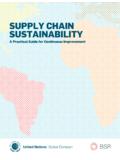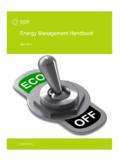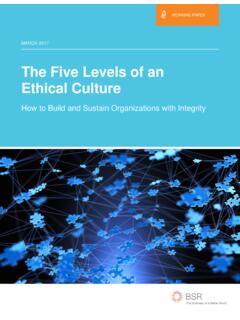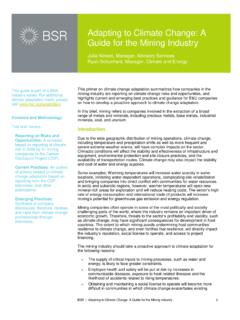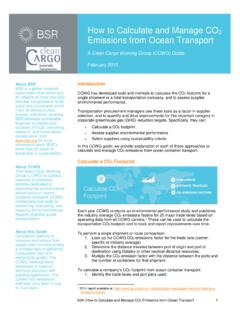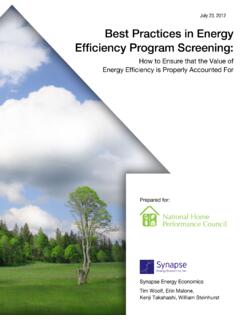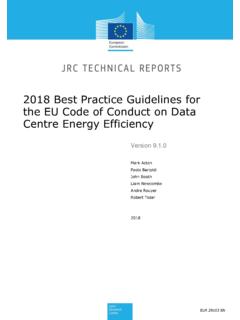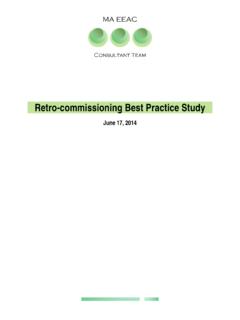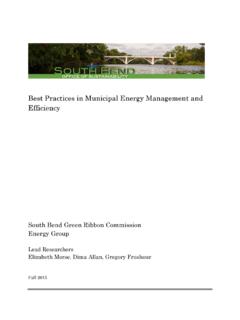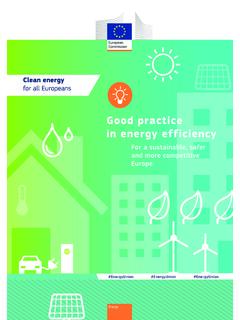Transcription of Energy Management Handbook - Home | BSR
1 Energy Management Handbook April 2012 2 BSR | Energy Management Handbook About The Handbook China has an ambitious goal of cutting Energy consumption per GDP by 20 percent of 2005 levels by 2015. To reach this goal, the government created the Comprehensive Scheme on Energy Saving and Emission Reduction in August 2011. The scheme is directed at large enterprises in key industries such as power generation and construction materials. Small and medium-sized enterprises, however, account for half of China s total annual Energy consumption and are about 30 to 60 percent less Energy -efficient than larger companies. Improving Energy Management of SME scan significantly help China achieve its Energy conservation and emissions reduction goals. This Energy Management Handbook was created by BSR, a leader in sustainability Management , after a series of studies on manufacturing SMEs. The studies examined the challenges faced by these companies, and explored cost-effective Energy -saving methods.
2 This booklet teaches SMEs how to establish Energy Management systems, explains the concepts and procedures of an Energy audit, and introduces methods of Energy efficiency diagnostics as well as Energy efficiency technologies and best practices . We also make practical and easy to operate recommendations to SMEs from both Management and technical perspectives. The Handbook was written by Fengyuan Wang of BSR Hong Kong and Andy Chen of BSR Guangzhou. The authors would like to thank Starbucks Coffee Company and its China-based suppliers for their contribution in the research, and the British Foreign & Commonwealth Office for its funding support. DISCLAIMER BSR publishes occasional papers as a contribution to the understanding of the role of business in society and the trends related to corporate social responsibility and responsible business practices . BSR maintains a policy of not acting as a representative of its membership, nor does it endorse specific policies or standards.
3 The views expressed in this publication are those of its authors and do not reflect those of BSR members. ABOUT BSR BSR works with its global network of nearly 300 member companies to build a just and sustainable world. From its offices in Asia, Europe, and North and South America, BSR develops sustainable business strategies and solutions through consulting, research, and cross-sector collaboration. Visit for more information about BSR s more than 20 years of leadership in sustainability. 3 BSR | Energy Management Handbook Contents 4 Energy Management System Overview Establishing a Management System 15 Energy Audit Overview Key Factors of an Energy Audit 26 Energy Saving for Large Energy -Consuming Systems Power Distribution Systems Lighting Systems Compressed Air Systems Air-Conditioning and Ventilation Systems Injection-Molding Systems 4 BSR | Energy Management Handbook Energy Management System 1.
4 Overview China's huge population and rapid pace of economic growth make its Energy needs particularly challenging. After two decades of annual growth averaging eight percent, it is now the world's second largest Energy consumer after the United States, according to the International Energy Agency (IEA). China s National Bureau of Statistics reports consumption of coal in China rose percent to billion tons in 2009, outpacing supply, which rose 18 percent to billion tons from its 2006 equivalent. (See Table 1-1 Energy consumption and supply (2006-2009) below). As a result, the government is facing a series of challenges to expand its Energy supply while increasing efficiency . Table 1-1: Energy production vs. Energy consumption (2006-2009) The bulk of the demand comes from the industrial sector, which is often hampered by shortages as rising consumption puts pressure on domestic Energy reserves. In 2011, China s major industrial provinces, Guangdong, Guangxi, Guizhou, Yunnan and Hainan, suffered from the worst power shortages since 2006.
5 In May 2011, power regulators were forced to impose off-peak periods in the Pearl River Delta industrial area of Guangdong province, affecting industrial towns located in the area, namely Dongguan, Shenzhen and Foshan, in an attempt to reduce power consumption. To meet year-end targets, 60 percent of small factories in Dongguan for instance, only received electricity three days a week, while companies in Baoan and Shenzhen had six days of electricity supply, as opposed to seven full days. Similarly, factories in 21 towns in Dongguan, including Shijie, Tanxia and Dalang only operate four days a week. These severe shortages combined with the rising value of the Yuan have raised costs for local businesses and depleted their profit margins. China is at a highly Energy -intensive stage of growth, consuming nearly 10 percent of the world s Energy resources. But government intervention through the introduction of Energy saving schemes presents opportunities to enhance efficiency in the industrial sector.
6 Companies, the majority of which are SMEs, Energy consumption and supply Unit: 10,000 tons of standard coal Gross Energy production Total Energy consumption 5 BSR | Energy Management Handbook will benefit from implementing such schemes to help them reduce power usage, increase Energy efficiency and reduce costs. The following chapters explain the benefits of implementing Energy Management systems and offers best practice advice to help SMEs use Energy more efficiently. Energy Management SYSTEM STANDARDS: ISO50001 AND GB/T23331-2009 China s Standard Certification Center (CSC) began research into improving Energy Management systems and upgrading national standards in 2002. In 2009, the government implemented its newly developed research GB/T 23331-2009, "Requirements for Energy Management Systems." Since then, China has made regular updates to its systems to match national standards with those of the International Organization for Standardization (ISO), which published its latest international Energy Management standards, the ISO 50001, in June 2011.
7 Organizations across the world face Energy -related challenges, including those related to Energy supply, reliability and climate change matters. The ISO 50001 is a framework that helps companies manage their Energy systems and plan better to save Energy and to reduce pollution as well as costs. ISO estimates these standards can reduce global Energy consumption by 60 percent. The ISO 50001 provides the following benefits: Resolves Energy efficiency problems Improves Energy usage of Energy -consuming assets Estimates environmental impact of greenhouse gases; Improves Energy Management and communication; Provides best practices for Energy efficiency ; Prioritizes new Energy -saving technology; Improves Energy efficiency of supply chains; and Details greenhouse gas reduction plans Both ISO50001 and GB/T23331-2009 are based on the same model (See Energy Management model), which applies the Plan, Do, Check and Action cycle (PDCA).
8 This Handbook provides China-based companies, particularly SMEs, with an overview of ISO 50001 as it relates to the Chinese GB/T23331-200 standard. 2. Establishing an Energy Management System Management COMMITMENT Both international and Chinese Energy Management standards require the support of senior managers to commit to facilitating Energy efficiency throughout their organizations. These include commitments to establish, implement, maintain and improve Energy Management systems on a regular basis. Specifically, managers must commit in writing to: Integrate Energy policies and regulations into company operations; Incorporate Energy targets into overall business strategies; Provide staff with Energy Management training; Figure 1-2: Energy Management Model 6 BSR | Energy Management Handbook A good Energy manager should display the following competences: A senior/middle class manager who can report to the top Management directly; Be familiar with main production processes; Have a certain understanding of production equipment, electrical, boiler, air-conditioning, lighting, and auxiliary systems; Have a certain degree of financial knowledge and Energy Management ; and Strong Management ability and is able to implement improvement plans independently.
9 Conduct Management reviews of Energy Management processes; and Keep Energy -related equipment well maintained. Energy Saving Commitments Establish a system to collect, analyze, and report data related Energy consumption, and ensure correctness and integrity of that data; Designate personnel with expertise and technical experience, or above, to be in charge of Energy Management , and file this personnel in government agencies in charge of Energy saving; Enhance measuring instrument Management and equip and use qualified measuring instruments according to relevant regulations; Establish a responsibility system and award organizations and individuals with good performance in Energy -saving activities; Make and implement Energy -saving plans and technical measures; Comply with national Energy limitation standards and make corporate standards that are stricter than national standards; Use Energy efficiency markings on products according to relevant regulations.
10 Conduct Energy -saving education and training regularly; Never produce, import, or sell any products or equipment (or use equipment) that are clearly specified as "to be eliminated" by government agencies or those which do not conform with Energy efficiency standards; Never provide free Energy to employees or implement any "package fee" system for Energy use. These commitments should be printed and posted in public areas in the factory to promote Energy Management . Energy POLICY (OPTIONAL) National and international Energy Management standards encourage companies to create Energy policies specific to their company operations. But implementation of these policies is up to the discretion of managers and companies. Good Energy policies: Are integrated with the company s business activities, products and services; Reduce Energy consumption, increase efficiency and guarantee regular system maintenance; Comply with applicable laws and regulations; Provide a framework for making and evaluating Energy targets and indicators; Offer employees training materials so that they can understand and implement Energy policies; and Are readily available to all relevant parties within the organization.


